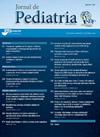出院时的喂养方式与巴西早产儿营养状况的关系:一项多中心研究
IF 2.8
4区 医学
Q1 PEDIATRICS
引用次数: 0
摘要
方法 作者研究了 2012 年 1 月至 2020 年 12 月间巴西 12 家新生儿重症监护病房的 4062 名胎龄 32 周、体重 1500 克的存活早产儿。出院/转院时的饮食类型分为纯母乳、纯配方奶或混合饮食。研究结果包括出院时的体重和头围,以及从出生到出院期间这两项指标的变化情况。作者使用线性回归估算了饮食类型与婴儿体型的调整关联,包括总体关联和按胎儿生长类别(小于胎龄与适合胎龄)分层的关联。作者还研究了出院时的饮食和婴儿体型在过去几年中的变化趋势。结果婴儿出生时的平均胎龄为 29.3 周,平均出生体重为 1136 克。出院/转院时的饮食中,22% 为纯母乳喂养,62% 为混合喂养,16% 为纯配方喂养。在所有饮食中,婴儿的体重和头围都大大低于生长图表的参考值。与只喂配方奶粉的婴儿相比,喂人奶和混合饲料的婴儿出院/转院时体重较轻,头围较小(体重 z:-2.0、-1.8 和-1.5;头部 z:-结论结果表明,在住院的巴西极早产儿中,人奶的使用率很高,但在营养素的输送方面却存在差距,而且随着时间的推移,几乎没有改善的迹象。本文章由计算机程序翻译,如有差异,请以英文原文为准。
Association between type of feeding at hospital discharge and nutritional status of Brazilian very preterm infants: a multicenter study
Objectives
To examine trends over time in diet and size of very preterm infants, and associations of diet with size at hospital discharge/transfer.
Methods
The authors studied 4062 surviving very preterm infants born < 32 weeks’ gestational age and < 1500 g between January 2012 and December 2020 from 12 Brazilian Neonatal Intensive Care Units. Diet type at discharge/transfer was classified as exclusive human milk, exclusive formula, or mixed. Outcomes were weight and head circumference at hospital discharge and the change in each from birth to discharge. The authors used linear regression to estimate adjusted associations of diet type with infant size, overall, and stratified by fetal growth category (small vs. appropriate for gestational age). The authors also examined trends in diet and infant size at discharge over the years.
Results
Infants’ mean gestational age at birth was 29.3 weeks, and the mean birth weight was 1136 g. Diet at discharge/transfer was exclusive human milk for 22 %, mixed for 62 %, and exclusive formula for 16 %. Infant size in weight and head circumference were substantially below the growth chart reference for all diets. Infants fed human milk and mixed diets were lighter and had smaller heads at discharge/transfer than infants fed formula only (weight z: −2.0, −1.8, and −1.5; head z: −1.3, −1.2 and −1.1 for exclusive human milk, mixed and exclusive formula respectively).
Conclusion
Results suggest high human milk use but gaps in nutrient delivery among hospitalized Brazilian very preterm infants, with little evidence of improvement over time.
求助全文
通过发布文献求助,成功后即可免费获取论文全文。
去求助
来源期刊

Jornal de pediatria
医学-小儿科
CiteScore
5.60
自引率
3.00%
发文量
93
审稿时长
43 days
期刊介绍:
Jornal de Pediatria is a bimonthly publication of the Brazilian Society of Pediatrics (Sociedade Brasileira de Pediatria, SBP). It has been published without interruption since 1934. Jornal de Pediatria publishes original articles and review articles covering various areas in the field of pediatrics. By publishing relevant scientific contributions, Jornal de Pediatria aims at improving the standards of pediatrics and of the healthcare provided for children and adolescents in general, as well to foster debate about health.
 求助内容:
求助内容: 应助结果提醒方式:
应助结果提醒方式:


